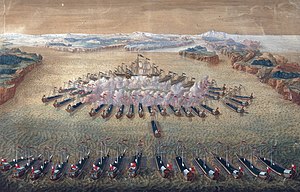Baltic Fleet
The Baltic Fleet (Russian: Балтийский флот,[1] translit. Baltiyskiy flot) is the fleet of the Russian Navy in the Baltic Sea.
| Baltic Fleet | |
|---|---|
| Russian: Балтийский флот | |
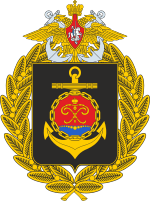 Baltic Fleet Great ensign | |
| Active | 18 May 1703 – present |
| Allegiance | (1703–1721) (1721–1917) (1917–1922) (1922–1991) (1991–present) |
| Branch | |
| Role | Naval warfare Amphibious warfare |
| Size | 60 Warships 3 Submarines |
| Part of | |
| Garrison/HQ | Kaliningrad (HQ) Baltiysk Kronshtadt |
| Anniversaries | 18 May |
| Engagements | Great Northern War
Seven Years' War Russo-Swedish War (1788–1790) Russo-Turkish Wars Crimean War Russo-Japanese War World War I Russian Civil War World War II |
| Decorations | |
| Commanders | |
| Current commander | Admiral Aleksandr Nosatov |
| Notable commanders | Rear Adm. Aleksandr Vladimirovich Razvozov Adm. Samuel Greig Cpt. Alexey Schastny Adm. Arseniy Golovko Vice Adm. Alexander Vekman Adm. Lev Galler Fleet Adm. Ivan Isakov Adm. Vladimir Yegorov Adm. Ivan Kapitanets Adm. Konstantin Makarov Adm. Viktor Chirkov |
Established 18 May 1703, under Tsar Peter the Great as part of the Imperial Russian Navy, the Baltic Fleet is the oldest Russian Navy formation.[2] In 1918 the fleet was inherited by the Russian SFSR then the Soviet Union in 1922, where it was eventually known as the Twice Red Banner Baltic Fleet as part of the Soviet Navy, as during this period it gained the two awards of the Order of the Red Banner. Following the collapse of the Soviet Union in 1991, the Baltic Fleet was inherited by the Russian Federation and reverted to its original name as part of the Russian Navy.
The Baltic Fleet is headquartered in Kaliningrad and its main base in Baltiysk, both in Kaliningrad Oblast, and another base in Kronshtadt, Saint Petersburg in the Gulf of Finland.
Imperial Russia
The Imperial Russian Baltic Fleet was created during the Great Northern War at the initiative of Czar Peter the Great, who ordered the first ships for the Baltic Fleet to be constructed at Lodeynoye Pole in 1702 and 1703. The first commander was a recruited Dutch admiral, Cornelius Cruys, who in 1723 was succeeded by Count Fyodor Apraksin. In 1703, the main base of the fleet was established in Kronshtadt. One of the fleet's first actions was the taking of Shlisselburg. In 1701 Peter the Great established a special school, the School of Mathematics and Navigation (Russian: Школа математических и навигацких наук), situated in the Sukharev Tower in Moscow. As the territory to the west around the Gulf of Finland was acquired by Russia for a "warm-water" port giving access for its merchantmen and the buildup of a naval force, the city of St. Petersburg was built and developed an extensive port. The School of Mathematics and Navigation was moved to St. Petersburg and in 1752 it was renamed the Naval Cadet Corps. Today it is the St. Petersburg Naval Institute – Peter the Great Naval Corps.
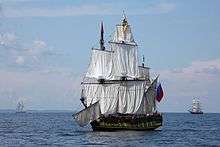
The Baltic Fleet began to receive new vessels in 1703. The fleet's first vessel was the 24-gun three-masted frigate Shtandart. She was the fleet's flagship, and is a prime example of the increasing role of the frigate design.
By 1724, the fleet boasted 141 sail warships and hundreds of oar-propelled vessels (galleys).
During the Great Northern War, the Baltic Fleet assisted in taking Viborg, Tallinn, (Estonia), Riga, (Latvia), the West Estonian archipelago (Moonsund archipelago), Helsinki, (Finland), and Turku. The first claimed victories of the new Imperial Russian Navy were the Gangut (Swedish: Hangöudd) in 1714 and, arguably, the Grengam (Swedish: Ledsund) in 1720. From 1715, the English Royal Navy intervened in the Baltic Sea on behalf of the German principality of Hanover, (dynastic home of the current British monarchy) and more or less in a tacit alliance with Russia. During the concluding stages of the war, the Russian fleet would land troops along the Swedish coast to devastate coastal settlements. However, after the death of King Charles XII, the Royal Navy would rather protect Swedish interests after a rapprochement between the Kingdom of Sweden and King George I. A Russian attempt to reach the Swedish capital of Stockholm was checked at the Battle of Stäket in 1719. The losses suffered by the Russian Navy at the Grengam in 1720, as well as the arrival of a Royal Navy squadron under Admiral John Norris, also prevented further operations of any greater scale before the war ended in 1721.
During the "Seven Years' War", (1755–1763), the Russian Baltic Sea fleet was active on the Pomeranian coast of northern Germany and Prussia, helping the infantry to take Memel in 1757 and Kolberg in 1761. The Oresund was blockaded in order to prevent the British Navy from entering the Baltic sea. During the Russo-Swedish War (1788–1790) the fleet, commanded by Samuel Greig, checked the Swedes at Hogland (1788) and the Viborg (1790). An impetuous Russian attack on the Swedish galley flotilla on 9 July 1790 at the Second Battle of Svensksund resulted in a disaster for the Russian Navy who lost some 9,500 out of 14,000 men and about one third of their flotilla. The Russian defeat in this battle effectively ended the war.
During the series of Russo-Turkish Wars, (1710–1711, 1735–1739, 1768–1774, 1787–1792, 1806–1812, 1828–1829), the fleet sailed into the Mediterranean Sea on the First and Second Archipelago Expeditions and destroyed the Ottoman Imperial Navy at the sea Battles of Chesma (1770), the Dardanelles (1807), Athos (1807), and Navarino (1827). At about the same time, Russian Admiral Ivan Krusenstern circumnavigated the globe, while another Baltic Fleet officer – Fabian Gottlieb von Bellingshausen – discovered the southern ice-covered continent, Antarctica.
In the Crimean War, (1853–1856), the fleet – although stymied in its operations by the absence of steamships – prevented the British and French Allies from occupying Hangö, Sveaborg, and Saint Petersburg. Despite being greatly outnumbered by the technologically superior Allies, it was the Russian Fleet that introduced into naval warfare such novelties as torpedo mines, invented by Boris Yakobi. Other outstanding inventors who served in the Baltic Fleet were Alexander Stepanovich Popov (who was the first to demonstrate the practical application of electromagnetic (radio) waves[3]), Stepan Makarov (the first to launch torpedoes from a boat), Alexei Krylov (author of the modern ship floodability theory), and Alexander Mozhaiski (co-inventor of aircraft).
Age of iron
As early as 1861, the first armor-clad ships were built for the Baltic Fleet. In 1863, during the American Civil War, most of the Fleet's ocean-going ships, including the flagship Alexander Nevsky were sent to New York City. At the same time ten Uragan-class monitors based on the American-designed Passaic-class monitors were launched. It was the policy of the Czar and his government to show support for the Northern Union Army in the United States during their Civil War, observing and exchanging naval tactics and cooperation. In 1869, the fleet commissioned the first turret on a battleship in the world – Petr Veliky. Furthermore, in the second half of the 19th and early 20th Century a strong network of coastal artillery batteries was created to cover the approaches to St. Petersburg, Riga, and other important bases.
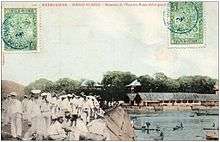
The Baltic Fleet took a prominent part in the Russo-Japanese War. After the defeat of earlier Siberian Military Flotilla vessels, in September 1904, a squadron under the command of Admiral Zinovy Rozhestvensky was sent on a famous high-speed dash around South Africa – stopping in French, German and Portuguese colonial ports: Tangier in Morocco, Dakar in Senegal, Gabon, Baía dos Tigres, Lüderitz Bay, and Nossi Be (Madagascar), then across the Indian Ocean to Cam Ranh Bay in French Indochina and then northward to its doomed encounter with the Japanese fleet at the Battle of Tsushima off the east coast of Korea in 1905, ending the Russo-Japanese War. The Imperial German civilian passenger Hamburg-Amerika Line provided 60 colliers to supply the Baltic Fleet on its epic journey. During its passage through the North Sea the Fleet mistook a fleet of British fishing boats for Japanese torpedo boats and opened fire, killing three sailors in what is known as the "Dogger Bank incident". The decision to send the Fleet to the Pacific was made after Russia had suffered a string of naval defeats in the East China Sea and the Sea of Japan off the coast of China and Korea near its Far East naval base and colony, at the hands of the newly emergent Imperial Japanese Navy and Army in Manchuria. The Tsushima naval battle broke Russian strength in East Asia. It set the stage for the unsuccessful uprising in the abortive Russian Revolution of 1905. That propelled the decline that would see the Romanov dynasty monarchy eventually brought down with the strains of World War I, in the Russian Revolutions of 1917.
World War I
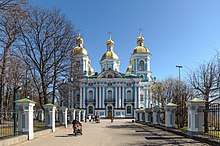
Following the catastrophic losses in battleships during the Russo-Japanese War, Russia embarked on a new naval building program which was to incorporate a number of the most modern dreadnought-type battleships into the fleet along with other vessels and practices adopted from the Western navies. In late 1914, four dreadnoughts of the Gangut class entered service with the Fleet: Gangut; Poltava; Petropavlovsk; and Sevastopol. Four more powerful battlecruisers of the Borodino class were under construction, but were never completed. On the whole the heavy units of the Fleet remained in port during the war, as the Imperial German Navy's superiority in battleships and other vessels was overwhelming and it was difficult to communicate with Great Britain's Royal Navy forces further west in the North Sea even though they had the Germans bottled up after the Battle of Jutland in 1916.
The Imperial Russian Navy's Baltic Fleet included a submarine division that had about 30 submarines of several classes and various auxiliary vessels, the largest of which were the transport and mother ships Europa, Tosno, Khabarovsk, Oland and Svjatitel Nikolai.[4][5] Some of the Fleet's 355-ton submarines were made by Electric Boat Company of Groton, Connecticut in the United States, main supplier and builder of subs for the U.S. Navy. Five of these "AG (Holland)" class submarines were prefabricated by the British Pacific Engineering & Construction Company at Barnet (near Vancouver), in Canada's British Columbia, also under contract to the Electric Boat Company. These Canadian-built subs were shipped to Russia, a fellow Ally in the First World War in December 1915.,[6][7] Four of these submarines, AG 11, AG 12, AG 15 and AG 16 were scuttled in the harbour of Hanko on 3 April 1918, just before the 10,000-strong Imperial German Baltic Sea Division landed in support of the "Whites" forces in the little known Finnish Civil War. During the war the Fleet was aided by a detachment of British Royal Navy submarines. These subs were later scuttled by their crews near the Harmaja lighthouse outside Helsinki, Finland, on 4 April 1918.[8]
Soviet era
October Revolution and Russian Civil War (1917–22)
During the October Revolution the sailors of the Baltic Fleet (renamed "Naval Forces of the Baltic Sea" in March 1918)[9] were among the most ardent supporters of Bolsheviks, and formed an elite among Red military forces. The fleet was forced to evacuate several of its bases after Russia's withdrawal from the First World War, under the terms of the Treaty of Brest-Litovsk. The "Ice Cruise" of the Baltic Fleet (1918), led by Alexey Schastny, saw the evacuation of most of the fleet's ships to Kronstadt and Petrograd.
Some ships of the fleet took part in the Russian Civil War, notably by clashing with the British navy operating in the Baltic as part of intervention forces.[10] Over the years, however, the relations of the Baltic Fleet sailors with the Bolshevik regime soured, and they eventually rebelled against the Soviet government in the Kronstadt rebellion in 1921, but were defeated, and the Fleet de facto ceased to exist as an active military unit.
1922–41
The Fleet, renamed the Red-Banner Baltic Fleet on 11 January 1935,[9] was developed further during the Soviet years, initially relying on tsarist warships, but adding modern units built in Soviet yards from the 1930s onwards. Among the Fleet's Soviet commanders were Gordey Levchenko in 1938–39 and Arseniy Golovko in 1952–56. Ships and submarines commissioned to the fleet included Soviet submarine M-256, a Project 615 short-range attack diesel submarine of the Soviet Navy. The fleet also acquired a large number of ground-based aircraft to form a strong naval aviation force.
In September 1939, the fleet threatened the Baltic states as part of a series of military actions staged to encourage the Baltics to accept Soviet offers of "mutual assistance."[11][12] Subsequently, in June 1940, the fleet blockaded the Baltics in support of the Soviet invasion.
Winter War
Finland, which had refused to sign a "pact of mutual assistance", was attacked by the USSR. The fleet played a limited role in the Winter War with Finland in 1939–1940, mostly through conducting artillery bombardments of Finnish coastal fortifications. Many fleet aircraft were involved in operations against Finland, however. Its operations came to a close with the freezing of the Gulf of Finland during the exceptionally cold winter of that year.
World War II
In the beginning of the German invasion the Baltic Fleet had 2 battleships, 2 cruisers, 2 flotilla leaders, 19 destroyers, 48 MTBs, 65 submarines and other ships, and 656 aircraft. During the war the Fleet, commanded by the Vice-Admiral Vladimir Tributz, defended the Hanko Peninsula, Tallinn, several islands in Estonian SSR, and participated in the breakthrough breach of the Siege of Leningrad. 137 sailors of the Baltic Fleet were awarded a title of the Hero of the Soviet Union. For most of the war the fleet was trapped by German and Finnish minefields in Leningrad and nearby Kronstadt, the only bases left in Soviet hands on the Baltic coast. Another key factor was that the Finns had recaptured outer islands of the Gulf of Finland, Suursaari being the most important of them. Many of the fleet sailors fought on land as infantry during the siege. Only submarines could risk the passage into the open sea to strike at German shipping. They were particularly successful towards the end of the war, sinking ships like Wilhelm Gustloff, Steuben and Goya, causing great loss of life.
The Fleet carried out the Soviet evacuation of Tallinn in late August 1941.
Grouping in June 1941
- Battleship squadron/division
- battleship Marat (named after Jean-Paul Marat)
- battleship Oktyabrskaya Revolutsiya (named after October revolution)
- destroyer leader Leningrad (named after the city of Leningrad)
- destroyer leader Minsk (named after the capital of Belarus)
- 1st destroyer division/1 Flotilla
- cruiser Kirov
- destroyer Gnevny
- destroyer Gordyy
- destroyer Grozyashchiy
- destroyer Smetlivyi
- destroyer Steregushchy
- 2nd destroyer division/2 Flotilla
- 3rd destroyer division/3 Flotilla
- Karl Marx
- Volodarsky
- Lenin
- Yakov Sverdlov
- Artiom
- Engels
- Kalinin
- Guards division/Naval Guards Squadron
- Burya
- Sneg
- Taifun
- Tsiklon
- Tucha
- Vihr
- Minesweeper Division/Task Group
- Minelayer Marti
- Minesweepers T-201, T-202, T-203, T-204, T-205, T-206, T-207, T-208, T-209, T-210, T-211, T-212, T-213, T-214, T-215, T-216, T-217 and T-218
- 15 auxiliary minesweepers
- 1st submarine brigade/1 Submarine Battle Fleet
- 2nd submarine brigade/2 Submarine Battle Fleet
- Support vessels
- transport Eestirand (VT 532)
- Oka (named after the river of Oka)
- Polyarnaya Zvezda (Polar Star)
- Training Task Group/Division of the Navy
- Training Task Group
Cold War
| Navies of Russia |
|---|
|
During the Immediate post-war period the importance of the Red-Banner Baltic Fleet increased despite the Baltic being a shallow sea with the exits easily becoming choke points by other countries. The Baltic Fleet was increased to two Fleets, the 4th Red-Banner Baltic Fleet and the 8th Red-Banner Baltic Fleet on 15 February 1946. However, during the post-Stalinist period and general reforms and downsizing in the Soviet Armed Forces the two fleets of the Baltic were again reduced, with many vessels, some built before the Revolution, were scrapped, and the Fleet was again renamed Red-Banner Baltic Fleet on 24 December 1955.[9]
In Liepāja the Baltic Fleet's 14th submarine squadron, call sign "Kompleks" ("Комплекс") was stationed with 16 submarines (613, 629a, 651); as was the 6th group of rear supply of Baltic Fleet, and the 81st design bureau and reserve command center of the same force.
Far from being reduced in importance, operations of the Red-Banner Baltic Fleet during the early-Cold War period earned it a great amount of prestige and profile, with the second awarding of the Order of Red Banner being presented on 7 May 1965 when the Fleet was again renamed to Twice Red-Banner Baltic Fleet.[9] Although the Soviet Union poured resources into building up the Northern Fleet and the Pacific Fleet, both of which had easy access to the open ocean, the Twice Red-Banner Baltic Fleet assumed the very important position of supporting the northern flank of the European Theatre in case of a confrontation with NATO. This role was under-rated from the blue water navies perspective, but was seen as a highly valuable one from the strategic perspective of the Soviet General Staff planning. The Twice Red-Banner Baltic Fleet remained a powerful force, which in the event of war was tasked with conducting amphibious assaults against the coast of Denmark and Germany, in cooperation with allied Polish and East German naval forces.
A notable incident involving the fleet occurred in 1975 when a mutiny broke out on the frigate Storozhevoy. There were also numerous allegations by Sweden of Baltic Fleet submarines illegally penetrating its territorial waters. In October 1981 the Soviet Whiskey-class submarine U 137 ran aground in Swedish territorial waters, near the important naval base of Karlskrona, causing a serious diplomatic incident. Swedish naval vessels pulled the submarine into deeper water and permitted it to return to the Soviet fleet in early November.[14]
Commanders
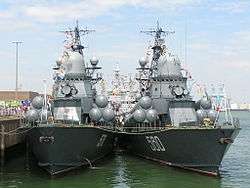
| Name[15] | Period of command |
|---|---|
| Nikolai Ottovich von Essen | 3 December 1909 – 7 May 1915 |
| Vasilii Aleksandrovich Kanin | 14 May 1915 – 16 September 1916 |
| Adrian Ivanovich Nepenin | 16 September 1916 – 4 March 1917 |
| Andrei Semyonovich Maksimov | 4 March 1917 – 1 June 1917 |
| Dmitry Nikolayevich Verderevsky | 1 June 1917 – 5 July 1917 |
| Aleksandr Vladimirovich Razvozov | 7 July – 5 December 1917 |
| Aleksandr Antonovich Ruzhek | 7 December 1917 – 13 March 1918 |
| Aleksandr Vladimirovich Razvozov | 13–20 March 1918 |
| Aleksey Mikhaylovich Shchastnyy | 22 March – 26 May 1918 |
| Sergey Valeryanovich Zarubayev | 27 May 1918 – 18 January 1919 |
| Aleksandr Pavlovich Zelenoy | 18 January 1919 – 2 July 1920 |
| Fedor Fedorovich Raskolnikov | 2 July 1920 – 27 January 1921 |
| Vladimir Andreyevich Kukel (Acting) | 27 January – 3 March 1921 |
| Ivan Kuzmich Kozhanov | 3 March – 4 May 1921 |
| Mikhail Vladimirovich Viktorov | 4 May 1921 – 6 May 1924 |
| Aleksandr Karlovich Vekman | 1924–1926 |
| Mikhail Vladimirovich Viktorov | 1926–1932 |
| Lev Mikhaylovich Galler | 22 August 1932 – 25 January 1937 |
| Aleksandr Kuzmich Sivkov | 25 January – 15 August 1937 |
| Ivan Stepanovich Isakov | 15 August 1937 – 9 January 1938 |
| Gordey Ivanovich Levchenko | 10 January 1938 – 27 April 1939 |
| Vladimir Filippovich Tributs | 28 April 1939 – 15 February 1946 |
In 1946 the Baltic Fleet was split into two commands, the 4th and 8th Fleets
| 4th Fleet | 8th Fleet | ||
|---|---|---|---|
| Gordey Ivanovich Levchenko | February 1946 – March 1947 | Vladimir Filippovich Tributs | February 1946 – May 1947 |
| Vladimir Aleksandrovich Andreyev | March 1947 – August 1952 | Fyodor Vladimirich Zozulya | May 1947 – February 1950 |
| Arseniy Grigoriyevich Golovko | August 1952 – December 1955 | Nikolay Mikhaylovich Kharlamov | February 1950 – December 1954 |
| Vladimir Afanasyevich Kasatonov | December 1954 – December 1955 | ||
In 1956 the two fleets were reunited into a single Baltic Fleet command
| Name[15] | Period of command |
|---|---|
| Arseniy Grigoryevich Golovko | 27 January – 24 November 1956 |
| Nikolay Mikhaylovich Kharlamov | 24 November 1956 – 29 May 1959 |
| Aleksandr Evstafyevich Orel | 29 May 1959 – 27 January 1967 |
| Vladimir Vasilyevich Mikhaylin | 27 January 1967 – 1 September 1975 |
| Anatoliy Mikhaylovich Kosov | 1 September 1975 – 2 June 1978 |
| Vladimir Vasilyevich Sidorov | 2 June 1978 – 12 February 1981 |
| Ivan Matveyevich Kapitanets | 12 February 1981 – 25 February 1985 |
| Konstantin Valentinovich Makarov | 25 February 1985 – 30 December 1985 |
| Vitaliy Pavlovich Ivanov | 30 December 1985 – December 1991 |
| Vladimir Grigoryevich Yegorov | 13 December 1991 – 2000 |
| Vladimir Prokofyevich Valuyev | 11 April 2001 – May 2006 |
| Konstantin Semenovich Sidenko | May 2006 – 6 December 2007 |
| Viktor Nikolayevich Mardusin | 6 December 2007 – 8 September 2009 |
| Viktor Viktorovich Chirkov | 8 September 2009 – May 2012 |
| Viktor Petrovich Kravchuk | May 2012 – 29 June 2016 |
| Aleksandr Mikhailovich Nosatov | 29 June 2016 (acting), confirmed 17 September 2016 |
Under the Russian Federation
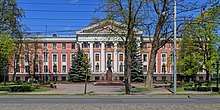
The breakup of the Soviet Union deprived the Fleet of key bases in Estonia, Latvia and Lithuania, leaving Kaliningrad Oblast as the Fleet's only ice-free naval outlet to the Baltic Sea. However, the Kaliningrad Oblast between Poland and Lithuania is not contiguous with the rest of the national territory of the Russian Federation.
In 1989 3rd Guards Motor Rifle Division at Klaipeda was transferred to the fleet as a coastal defence division. It was disbanded on 1 September 1993.
In the late 1990s the 336th Guards Naval Infantry Brigade and the remnant of the 11th Guards Army of the Baltic Military District were subordinated to a single command named the Ground and Coastal Forces of the Baltic Fleet under a deputy fleet commander. The 11th Guards Army remnant included the 7th Guards Motor Rifle Regiment and the brigade that was the former 18th Guards Motor Rifle Division, plus several Bases for Storage of Weapons and Equipment, holding enough vehicles and weaponry for a division but only having a few hundred men assigned to maintain the equipment and guard the bases. warfare.be listings in 2013 report that the staff of the Ground and Coastal Defence Forces of the Fleet may have been disbanded in November 2007.
In 2007, according to the IISS, the fleet's aviation units were equipped with a total of 23 Su-27, 26 Su-24, 14 An-12/24/26, 2 An-12 Cub (MR/EW), 11 Mi-24 Hind, 19 Ka-28 Helix, 8 Ka-29 Helix assault helicopters, and 17 Mi-8 Hip transport helicopters.[17]
As of 2008 the Baltic Fleet included about 75 combat ships of various types.[18] The main bases is in Baltiysk and a second operational base is in Kronstadt. The Leningrad Naval Base is an administrative entity that is not a discrete geographic location but comprises all of the naval institutions and facilities in the St. Petersburg area. The assignment of the 106th Small Missile Ship Battalion is disputed; warfare.be places it under the 64th Naval Region Protection Brigade, while Holm, probably working from older sources, places it under the 36th Missile Ship Brigade.
In June 2016, fleet commander Vice Admiral Viktor Kravchuk and his chief of staff, Vice Admiral Sergei Popov, were dismissed for "serious training shortcomings and distortion of the real situation". N. G. Kuznetsov Naval Academy commander Vice Admiral Alexander Nosatov was made acting commander of the fleet, a position in which he was confirmed on 17 September.[19]
Forces
Operational forces include:
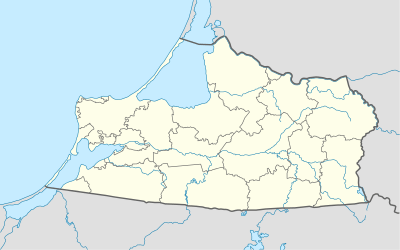
There is another brigade of the Polish 16th Mech Division to the east of the 15th Mech Bde
12th Surface ship Division
- 128th Surface ship Brigade[20] (128-я бригада надводных кораблей)
- Pylkiy (Krivak-class frigate) (702) (Navy Commander issued an order to write off the ship in 2012)
- Nastoychivyy (610) (Sovremenny-class destroyer) (1992)
- Neustrashimyy (Neustrashimyy-class frigate) (Entered service 1993)
- Yaroslav Mudryy (Neustrashimyy-class frigate) (Entered service 2009)
- Steregushchiy (530) (Steregushchy-class corvette) (2007)
- Soobrazitelnyy (531) (Steregushchy-class corvette) (2011)
- Boikiy (532) (Steregushchy-class corvette) (May 2013)[21]
- Stoikiy (545) (Steregushchy-class corvette) (2014)
- 71st Red Star Landing Ship Brigade (Baltiysk)
- Korolev (130) (Ropucha class LST)
- Minsk (122) (Ropucha class LST)
- Kaliningrad (102) (Ropucha class LST)
- Aleksandr Shabalin (110) (Ropucha class LST)
- Evgeniy Kocheshkov (770) (Zubr-class LCAC)
- Mordoviya (782) (Zubr-class LCAC)
- 123rd Submarine Brigade
- 1 Lada-class submarine
- B-585 Sankt Peterburg (According to the article on this boat it was assigned to the Northern Fleet after acceptance in 2014.)
- 2 Kilo-class submarines
- 1 Lada-class submarine
- 105th Naval Region Protection Brigade
- 144th Tactical Group (Kronshtadt) ex 109th ASW ships div
- 308 MPK 99 Zelenodolsk (Parchim-class corvette)
- 304 MPK 192 Urengoy (Parchim-class corvette)
- 311 MPK 205 Kazanets (Parchim-class corvette)
- 145th Tactical Group (Kronshtadt) ex-22nd Red Banner Minesweeper Battalion
- BT 115 (561) (Sonya-class minesweeper)
- PDKA 89 PDKA 910 RChT 702 (353) RChT 61 (324) RT 57 (316) RT 248 (348)
- 144th Tactical Group (Kronshtadt) ex 109th ASW ships div
Baltyysk Naval Base
- 64th Maritime Region Protection Brigade
- 146th Tactical Group (former 264th Anti-submarine Warfare Battalion, Project 1331)
- 218 MPK-224 Aleksin (Parchim-class corvette)
- 243 MPK-227 Kabardino-Balkaria (Parchim-class corvette)
- 232 MPK-229 Kalmykiya (Parchim-class corvette)
- 147th, 148th Tactical Groups (former 323rd Minesweeper Division)
- 4 Sonya-class minesweepers
- 146th Tactical Group (former 264th Anti-submarine Warfare Battalion, Project 1331)
- 36th Red Banner Order of Nakhimov Missile Ship Brigade[22]
- 1st Guards Missile Boat Battalion
- 106th Small Missile Ship Battalion – attached from 1 June 1994. (Project 1234)
- Liven' (551) (Nanuchka-class corvette)
- Geyzer (555) (Nanuchka-class corvette)
- Zyb' (560) (Nanuchka-class corvette)
- Passat (570) (Nanuchka-class corvette)
Ships whose unit allocation is not precisely known
- 2 Karakurt missile ship in the Baltyysk naval base's brigade of missile ships and boats.[23]
- 2 Buyan-M-class missile ships
- 2 Ondatra-class landing craft
- 1 Serna-class landing craft
- 7 Tarantul-class corvettes
- 4 Pauk-class corvette
- 1 Natya-class minesweeper – not listed by warfare.be
- 6 Lida-class minesweepers
- 1 Alexandrit-class minesweeper
- 3 Dyugon-class landing craft
Naval Aviation (2007):[24]
- HQ: Kaliningrad
- 689th Independent Fighter Aviation Regiment – Kaliningrad Chkalovsk[25] – operating Su-27;
- 4th Independent Naval Assault Aviation Regiment – Chernyakhovsk Air Base – operating Su-24M/MR;
- 125th Independent Helicopter Squadron – HQ at Chkalovsk – operating Mi-8, Mi-24 (this was the former 288th Independent Helicopter Regt of the 11th Guards Army and used to be at Nivenskoye);
- 396th Independent Shipborne Anti-Submarine Helicopter Squadron – Donskoye Air Base – Ka-27/PS, Ka-29;
- 398th Independent Air Transport Squadron – HQ at Khrabrovo – An-2, An-12, An-24, An-26, Be-12, Mi-8.


- 11th Army Corps (Baltic Fleet Coastal Forces) in Kaliningrad
- 7th Independent Guards Motorized Rifle Brigade (Kaliningrad)
- 79th Independent Guards Motorized Rifle Brigade (Gusev, Kaliningrad Oblast)
- 336th Guards Naval Infantry Brigade (Baltiysk)
- 244th Artillery Brigade (2A36/BM-21), in Kaliningrad
- 152nd Guards Missile Brigade (9K720 Iskander), at Chernyakhovsk Air Base
- 11th Independent Tank Regiment (Gusev, Kaliningrad Oblast)[26] (Military Unit Number V/Ch (в/ч) 41611)
- 25th Coastal Defence Missile Regiment (BAL-E/K-300P Bastion-P), at Donskoye Air Base
- 69th Guards Naval Engineer Regiment, in Gvardeysk
- 299th Training Center of Coastal Forces, in Gvardeysk
- 561st Reconnaissance Center, in Parusnoye
- 742nd Communication Center, in Kaliningrad
- 841st Independent Electronic Warfare Center, in Yantarny
- 313th Special Detachment of Anti-Sabotage Forces and Means, in Baltiysk
- 473rd Special Detachment of Anti-Sabotage Forces and Means, in Kronstadt
References
- [structure.mil.ru/structure/forces/type/navy/baltic.htm Baltic fleet official site]
- "Baltic Fleet turns 307". RusNavy.com. 18 May 2010. Archived from the original on 19 December 2010. Retrieved 17 May 2011.
- "Early Radio Transmission Recognized as Milestone". IEEE. Archived from the original on 16 January 2008. Retrieved 16 July 2006.
- During 1915–1917 the Estonian Master Mariner Johann Kalmar had command of Svjatitel Nikolai and then "Oland". Kalmar had been forcibly conscripted into the Tsar's Navy in 1914. He managed to evade the Bolsheviks ("Reds") communists during the second upheaval of 1917, the "October Revolution" and was later one of the founders of the merchant shipping firm Merilaid & Co.
- "Sotasurmat/ Helsinki maaliskuussa 1917/ Itämeren laivaston alukset". www.helsinki.fi. Archived from the original on 24 September 2015.
- http://naval.review.cfps.dal.ca/forum/pdf/08-02-Shirlaw-Submarines_Burrard.pdf%5B%5D
- Submarines of the Russian and Soviet Navies 1718 – 1990, Polmar, N. and Noot, J., Page 63, Naval Institute Press, Annapolis, 1990 ISBN 0-87021-570-1
- Finnish Navy in World War II Archived 15 May 2007 at the Wayback Machine
- "ВОЕННАЯ ЛИТЕРАТУРА --[ Военная история ]-- Боевой путь Советского Военно-Морского Флота". militera.lib.ru. Archived from the original on 20 February 2008.
- "Archived copy". Archived from the original on 6 February 2006. Retrieved 8 April 2006.CS1 maint: archived copy as title (link)
- Moscow's Week Archived 27 August 2013 at the Wayback Machine at Time Magazine on Monday, 9 October 1939
- The Baltic States: Estonia, Latvia and Lithuania by David J. Smith, Page 24, ISBN 0-415-28580-1
- Keskinen, Kalevi; Mäntykoski, Jorma, eds. (1991). The Finnish Navy At War in 1939–1945 (Suomen Laivasto Sodassa 1939–1945). Espoo: Tietoteos Ky. p. 153. ISBN 951-8919-05-4. OL 1778118M.
- "History – Sweden – issues, growth, future, power, policy, Sweden and Neutrality". www.nationsencyclopedia.com. Archived from the original on 6 August 2006.
- Боевой путь Советского Военно-морсого Флота, Военное Издательство, Moscow, 1988
- IISS (2007). The Military Balance 2007. London: Routledge for the IISS. p. 197. ISBN 978-1-85743-437-8.
- Kommersant VLAST, No.7(760) 25 February 2008
- "Вице-адмирал Носатов назначен командующим Балтийским флотом" [Vice Admiral Nosatov appointed Baltic Fleet commander]. TASS (in Russian). 22 September 2016. Archived from the original on 25 September 2016. Retrieved 2 October 2016.
- "128th Missile Ship Brigade". www.ww2.dk. Archived from the original on 4 March 2016.
- Interfax-AVN, Moscow, 0930 and 1250 GMT 16 May 13 Archived 10 November 2013 at the Wayback Machine
- "36th Missile Ship Brigade". www.ww2.dk. Archived from the original on 22 May 2013.
- "Archived copy". Archived from the original on 18 December 2018. Retrieved 19 December 2018.CS1 maint: archived copy as title (link)
- Air Forces Monthly, August 2007 issue.
- "Archived copy". Archived from the original on 11 October 2018. Retrieved 11 October 2018.CS1 maint: archived copy as title (link)
- https://www.militarynews.ru/story.asp?rid=1&nid=506496&lang=RU
- "Russian Anti-Access Area Denial (A2AD) capabilities – implications for NATO". pulaski.pl. 27 November 2016. Archived from the original on 11 May 2018.
- https://tass.com/defense/1080523
- Richard Connaughton, 1988, 1991, 2003. "Rising Sun and Tumbling Bear: Russia's War With Japan". Cassell. ISBN 0-304-36657-9.
- Jürgen Rohwer and Mikhail S. Monakov, Stalin's Ocean Going Fleet – Soviet Naval Strategy and Shipbuilding Programmes: 1935–1953, Frank Cass, 2001, ISBN 0-7146-4895-7.
- Gunnar Åselius, The Rise and Fall of the Soviet Navy in the Baltic, 1921–41, Routledge (UK), 2005, ISBN 978-0-7146-5540-6.
External links
| Wikimedia Commons has media related to Baltic Fleet. |
- Baltic Fleet – Morskoyo Flota ( Naval Force) – Russian and Soviet Nuclear Forces
- Baltic Fleet list March 1917
- https://russiandefpolicy.com/2020/06/02/demobbing-corrigenda/ -- manning of 11th Army Corps, 2020 calculations
